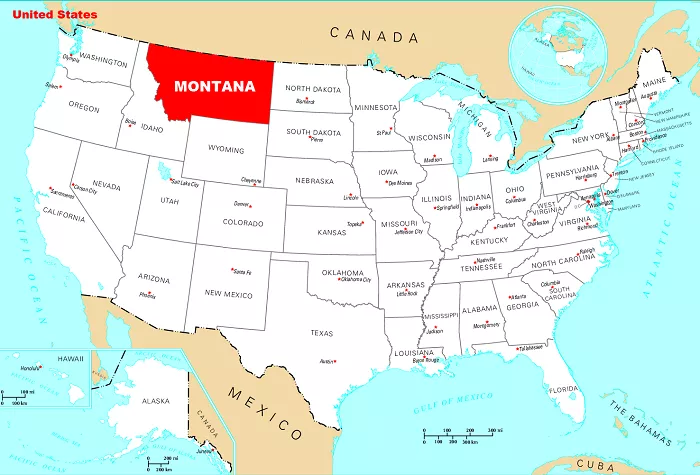Montana, often referred to as “Big Sky Country,” is a state in the northwestern region of the United States. Known for its expansive landscapes and rich history, understanding Montana’s location on the U.S. map provides insight into its geographical significance and neighboring regions.
Geographic Location of Montana
Montana is situated in the northwestern part of the United States. It shares its northern border with three Canadian provinces: British Columbia, Alberta, and Saskatchewan. To the east, it borders North Dakota and South Dakota; to the south, Wyoming; and to the west and southwest, Idaho.
The state’s geographical coordinates are approximately 47.0° N latitude and 110.0° W longitude.
This positioning places Montana among the eight Mountain States, highlighting its varied topography that includes both mountainous regions and expansive plains.
Montana’s Borders and Neighboring Regions
Montana’s extensive borders connect it to various U.S. states and Canadian provinces:
- North: The Canadian provinces of British Columbia, Alberta, and Saskatchewan.
- East: North Dakota and South Dakota.
- South: Wyoming.
- West and Southwest: Idaho.
This strategic location not only makes Montana a gateway between the U.S. and Canada but also positions it as a significant state within the Mountain West subregion.
Major Cities and Landmarks in Montana
Montana encompasses several notable cities and natural landmarks:
- Helena: The state capital, located in the west-central part of Montana.
- Billings: The largest city, situated in the south-central region, serving as a major financial and cultural center.
- Missoula: Known for its vibrant arts scene and proximity to natural attractions.
- Bozeman: Home to Montana State University and close to Yellowstone National Park.
- Glacier National Park: Located in the northern part of the state, renowned for its stunning landscapes and diverse ecosystems.
Montana’s Physical Geography
The state’s diverse terrain includes:
- Rocky Mountains: Dominating the western part of Montana, offering rugged landscapes and recreational opportunities.
- Great Plains: Covering the eastern regions, characterized by rolling plains and agricultural lands.
- Major Rivers: Such as the Missouri and Yellowstone rivers, which play crucial roles in the state’s ecology and economy.
Climate and Natural Resources
Montana experiences a varied climate:
- Western Montana: Features a mountainous climate with colder winters and milder summers.
- Eastern Montana: Exhibits a semi-arid climate with more significant temperature variations.
The state is rich in natural resources, including minerals like gold and silver, and has vast areas dedicated to agriculture and forestry.
Cultural and Historical Significance
Montana’s location has influenced its cultural and historical development:
- Indigenous Heritage: Home to several Native American tribes, each with unique traditions and histories.
- Lewis and Clark Expedition: The explorers traversed Montana during their journey to the Pacific Northwest.
- Mining Boom: The discovery of precious metals in the 19th century attracted settlers and contributed to economic growth.
Transportation and Accessibility
Montana’s position affects its transportation networks:
- Highways: Interstate 90 and Interstate 15 are major routes facilitating east-west and north-south travel, respectively.
- Air Travel: Airports in cities like Billings, Missoula, and Bozeman connect Montana to national and international destinations.
- Railroads: Freight and passenger rail services traverse the state, supporting commerce and tourism.
Tourism and Outdoor Activities
Montana’s diverse landscapes offer numerous recreational opportunities:
- National Parks: Glacier National Park and parts of Yellowstone National Park attract millions of visitors annually.
- Outdoor Recreation: Activities like hiking, fishing, skiing, and wildlife viewing are popular among residents and tourists.
Conclusion
Understanding Montana’s location on the U.S. map reveals its significance as a state rich in natural beauty, cultural heritage, and economic resources. Its borders with both U.S. states and Canadian provinces highlight its strategic position in North America. From the towering peaks of the Rockies to the expansive plains, Montana’s diverse geography offers a unique blend of environments that continue to shape its identity and allure.

